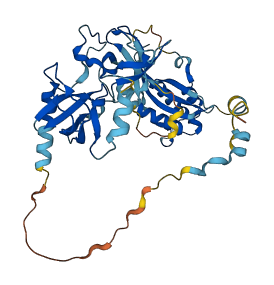O77774
Gene name |
NCF1 |
Protein name |
Neutrophil cytosol factor 1 |
Names |
NCF-1, 47 kDa neutrophil oxidase factor, NCF-47K, Neutrophil NADPH oxidase factor 1, p47-phox |
Species |
Bos taurus (Bovine) |
KEGG Pathway |
bta:281345 |
EC number |
|
Protein Class |
|

Descriptions
Autoinhibitory domains (AIDs)
Target domain |
156-215 (N-SH3); 226-285 (C-SH3) |
Relief mechanism |
PTM |
Assay |
|
Accessory elements
No accessory elements
References
- Yuzawa S et al. (2004) "A molecular mechanism for autoinhibition of the tandem SH3 domains of p47phox, the regulatory subunit of the phagocyte NADPH oxidase", Genes to cells : devoted to molecular & cellular mechanisms, 9, 443-56
- Yuzawa S et al. (2003) "Crystallization and preliminary crystallographic analysis of the autoinhibited form of the tandem SH3 domain of p47(phox)", Acta crystallographica. Section D, Biological crystallography, 59, 1479-80
Autoinhibited structure

Activated structure

1 structures for O77774
| Entry ID | Method | Resolution | Chain | Position | Source |
|---|---|---|---|---|---|
| AF-O77774-F1 | Predicted | AlphaFoldDB |
No variants for O77774
| Variant ID(s) | Position | Change | Description | Diseaes Association | Provenance |
|---|---|---|---|---|---|
| No variants for O77774 | |||||
No associated diseases with O77774
6 regional properties for O77774
| Type | Name | Position | InterPro Accession |
|---|---|---|---|
| domain | SH3 domain | 156 - 215 | IPR001452-1 |
| domain | SH3 domain | 226 - 285 | IPR001452-2 |
| domain | Phox homology | 3 - 125 | IPR001683 |
| domain | Neutrophil cytosol factor 1, C-terminal | 360 - 392 | IPR015039 |
| domain | Neutrophil cytosol factor 1, PX domain | 6 - 123 | IPR034909 |
| domain | Neutrophil cytosol factor 1, first SH3 domain | 160 - 212 | IPR035756 |
5 GO annotations of cellular component
| Name | Definition |
|---|---|
| cytoplasm | The contents of a cell excluding the plasma membrane and nucleus, but including other subcellular structures. |
| cytosol | The part of the cytoplasm that does not contain organelles but which does contain other particulate matter, such as protein complexes. |
| extrinsic component of membrane | The component of a membrane consisting of gene products and protein complexes that are loosely bound to one of its surfaces, but not integrated into the hydrophobic region. |
| membrane | A lipid bilayer along with all the proteins and protein complexes embedded in it an attached to it. |
| NADPH oxidase complex | A enzyme complex of which the core is a heterodimer composed of a light (alpha) and heavy (beta) chain, and requires several other water-soluble proteins of cytosolic origin for activity. Functions in superoxide generation by the NADPH-dependent reduction of O2. |
3 GO annotations of molecular function
| Name | Definition |
|---|---|
| phosphatidylinositol binding | Binding to an inositol-containing glycerophospholipid, i.e. phosphatidylinositol (PtdIns) and its phosphorylated derivatives. |
| phosphatidylinositol-3,4-bisphosphate binding | Binding to phosphatidylinositol-3,4-bisphosphate, a derivative of phosphatidylinositol in which the inositol ring is phosphorylated at the 3' and 4' positions. |
| superoxide-generating NADPH oxidase activator activity | Increases the activity of the enzyme superoxide-generating NADPH oxidase. |
3 GO annotations of biological process
| Name | Definition |
|---|---|
| protein targeting to membrane | The process of directing proteins towards a membrane, usually using signals contained within the protein. |
| respiratory burst | A phase of elevated metabolic activity, during which oxygen consumption increases; this leads to the production, by an NADH dependent system, of hydrogen peroxide (H2O2), superoxide anions and hydroxyl radicals. |
| superoxide anion generation | The enzymatic generation of superoxide, the superoxide anion O2- (superoxide free radical), or any compound containing this species, by a cell in response to environmental stress, thereby mediating the activation of various stress-inducible signaling pathways. |
6 homologous proteins in AiPD
| UniProt AC | Gene Name | Protein Name | Species | Evidence Code |
|---|---|---|---|---|
| P14598 | NCF1 | Neutrophil cytosol factor 1 | Homo sapiens (Human) | EV |
| A6NI72 | NCF1B | Putative neutrophil cytosol factor 1B | Homo sapiens (Human) | SS |
| A8MVU1 | NCF1C | Putative neutrophil cytosol factor 1C | Homo sapiens (Human) | SS |
| P97369 | Ncf4 | Neutrophil cytosol factor 4 | Mus musculus (Mouse) | PR |
| Q09014 | Ncf1 | Neutrophil cytosol factor 1 | Mus musculus (Mouse) | SS |
| F1M707 | Ncf1 | Neutrophil cytosolic factor 1 | Rattus norvegicus (Rat) | SS |
| 10 | 20 | 30 | 40 | 50 | 60 |
| MGDHFIRHIA | LLGFEKRFVP | SQHYVYMFLV | KWQDLSEKVV | YRRFTEIYEF | HKILKEMFPI |
| 70 | 80 | 90 | 100 | 110 | 120 |
| EAGDINPENR | IIPHLPAPRW | YDGQRVAESR | QGTLTEYCST | LMSLPVKISR | CPHLLNFFKV |
| 130 | 140 | 150 | 160 | 170 | 180 |
| RPDDLKLPTD | SQVKKPETYL | MPKDGKNNAA | DITGPIILQT | YRAIADYEKG | SSSQMALATG |
| 190 | 200 | 210 | 220 | 230 | 240 |
| DVVDVVEKNE | SGWWFCQMKT | KRGWVPASYL | EPLDSPDEAE | DPEPNYAGEP | YITIKAYTAV |
| 250 | 260 | 270 | 280 | 290 | 300 |
| LEDEISLEEG | EAIEVIHKLL | DGWWVIRKED | VTGYFPSMYL | QKAGQDVAQA | KSQIKSRGAP |
| 310 | 320 | 330 | 340 | 350 | 360 |
| PRRSSIRNAH | SIHQRSRKRL | SQDTYRRNSV | RFMQQRRHQR | PEPQRSRSAL | REQQQPKTER |
| 370 | 380 | 390 | |||
| PKPQPAVPPR | PSADLILHRC | SESTKRKLAS | AV |